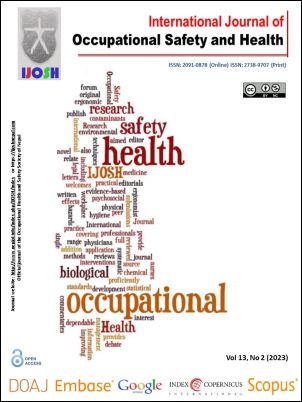Descriptive Epidemiology of Occupational Injuries among urban construction workers – an observation from Eastern India
DOI:
https://doi.org/10.3126/ijosh.v13i2.48712Keywords:
Occupational Injuries, Construction Workers, Musculoskeletal Injuries, Urban Migrant Workers, Work-related AccidentsAbstract
Introduction
Bhubaneswar, Odisha, is seeing a boom in construction activities, with workers from remote areas coming for work. Poverty, and illiteracy, coupled with employment and regular payments make them oblivious to unsafe working conditions. Long hours of heavy work in bad postures affect their musculoskeletal system leading to work-related musculoskeletal injuries. This study aimed to understand the epidemiology of the above injuries among the construction workers in Bhubaneswar
Methods
It was a work-site-based multistage cross-sectional study, where the sites engaging >=15 workers were selected randomly. A total of 520 workers (consented, >=21 years of age, and in this profession for at least 3 years) were recruited randomly. Data was collected by interviewing the study participants with the help of a pre-tested questionnaire focusing on sociodemographic profiles and relevant epidemiological variables related to occupational injury of urban construction workers. Data entry and analysis were done using SPSS version 20.
Results
Over 95% of the participants were heavy workers, 23.1% were laborers, 28.1% had < 10 years of experience, and 72.3% were satisfied with their job. A little more than 19% had work-related injuries in the last 3 months. Age, gender, alcohol abuse, better education, lesser work experience, skilled work and job dissatisfaction were found to be statistically significant when associated with workplace injuries. Multivariate analysis revealed only age and lesser duration of working experience in the construction industry were associated with an increase in occupational injuries.
Conclusion
This study found that younger age, less work experience, male gender, use of alcohol, nature of work and lack of job satisfaction, and a few other factors were associated with work-related injuries. Often their occupational health and injuries get overlooked. Employers should be primarily responsible for their health, safety, and well-being. Suitable legislation and proper implementation would probably facilitate this.
Downloads
Downloads
Published
How to Cite
Issue
Section
License
Copyright (c) 2023 Bidisa Sarkar, Sonali Kar, Ipsa Mohapatra, Kamalesh Sarkar

This work is licensed under a Creative Commons Attribution-NonCommercial 4.0 International License.
This license enables reusers to distribute, remix, adapt, and build upon the material in any medium or format for noncommercial purposes only, and only so long as attribution is given to the creator.





